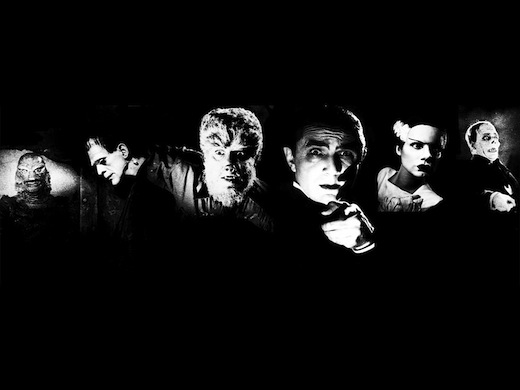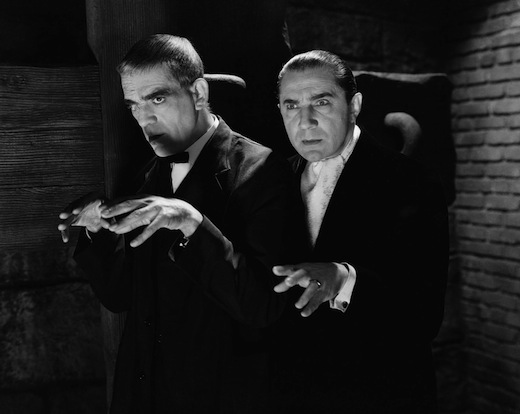The Golden Age of Monsters
By Eric Hehr in Arts & Entertainment on Oct 22, 2011 4:00PM

Universal Studios: The Golden Age of Horror
The Music Box's week-long retrospective of Universal Studios' horror movies kicked off last night. By now, most of these films are over 75 years old, yet they still manage to endure. What made these films significant in the first place, and why are they still being remade? What are modern horror films lacking in comparison, or inadequately borrowing from the Universal horror films of the thirties and forties?
Within a 15-year span, Universal single-handedly reinvented the horror genre. Just as Elvis and The Beatles began sharing the spotlight with Sinatra and Crosby as legitimate artists, so did horror and science fiction movies eventually replace the traditional Western as the staple movie genre.
In the 1930s, Universal created a monopoly on the mainstream horror film, producing stars such as Bela Lugosi [Dracula (1931), The Raven (1935), The Black Cat (1934)] and Boris Karloff [Frankenstein (1931), The Mummy (1932)], and grossing large sums of money at the box office in the process. Throughout the 30s and early 40s, no other studio had the same knack for producing consistently marketable horror films. Not only did Universal bring the subgenre of “creature features” into the limelight, they also gave them their golden years, now reflected back on as “The Monsters Golden Era.”
Today, the Universal Studios horror films from this period are seen as classics, and are considered to be the building blocks in the formation of one of the great mega-corporations of not only the film industry, but the entertainment industry at large. Within this short period of time, Universal was able to transform literary properties such as Bram Stoker's Dracula and Mary Shelley's Frankenstein into full fledged monster franchises, and no other American studio system has been able to do the same as successfully since. Much of this success can be attributed to Universal Studios founder, Carl Laemmle and his son, Carl, Jr.
In many of the horror films produced during this period of time, Junior’s artistic endeavors on the film’s left many shocked, but craving more. An example of this is a famous scene from Frankenstein, where The Monster (Boris Karloff) kills a young girl named Maria (Marilyn Harris) by letting her drown. Though the death in the original theatrical release was more or less insinuated instead of graphically depicted (you never saw The Monster throwing Maria into the lake*), it left many questioning the credibility of Junior and the studio.
On Nov. 14th, 1931, the recently incorporated trade paper, The Motion Picture Herald, covered the pre-release of Frankenstein: "I won't forgive Junior Laemmle or James Whale of Universal for permitting the monster to drown a little girl before my very eyes. That job should come out before the picture is released. It is too dreadfully brutal, no matter what the story calls for."
(*Later releases of Frankenstein, including the DVD version, have restored this scene. The scene, and especially Karloff's performance, help to establish The Monster as a sympathetic character, rather than a raging, mindless beast. - CS)
While some found scenes such as this to be far too disturbing and nauseating for the American audience, the shock value of these scenes created a buzz around the picture that only enticed more of the public to see it. Universal’s recognition of the importance of shock value in horror films would resonate in all horror films to follow, whether it be Janet Leigh’s shower scene in Psycho (1960), Linda Blair masturbating with a crucifix in The Exorcist (1973), Johnny Depp’s grotesquely exaggerated death sequence in A Nightmare on Elm Street (1984), or the torture sequences in Hostel (2005).

Carl Laemmle, Jr.
In fact, having a woman play the victim in a horror film was so influential to the genre it produced a subgenre known as “slasher films.”; This genre’s origins is most typically traced to the release of Bob Clark’s Black Christmas (1974), which in turn lead to a cycle of sister-films which peaked in the late seventies and early eighties with the release of John Carpenter's Halloween (1978), Sean S. Cunningham's Friday the 13th (1980) and Wes Craven's A Nightmare on Elm Street (1984), all of which spawned numerous sequels and countless imitators that endlessly recycled their predecessors' characters and plot.
The female victim is one of the most important aspects of the horror genre, and most mainstream horror films released since Universal's controversial decision to victimize the female gender have featured a woman or a series of women playing the victim to a creature or killer. Slasher films all involved a psychopathic killer who stalks and graphically murders a series of girls. While these archetypes and formulas in horror films were standard practice in the 70s and 80s, forty years before people thought such proposals would cause a film to either financially fail, or not even be released. The basic groundwork for horror films were instituted into the minds of the industry, the screens of the theaters, and the eyes and nightmares of the audience.
The Black Cat (1934) is in many senses the epitome of The Monsters Golden Age. It is also one of the most influential films on the horror genre (as well as film noir) that Universal released in the 1930’s. The two most famous actors of The Monsters Golden Era were Bela Lugosi and Boris Karloff. Both actors had found their fame at Universal in the early 30s, and the idea of casting Karloff and Lugosi together occurred to Universal in 1932, when a publicist arranged a photo session for the two.
The Black Cat is a very significant film from this period for many reasons, but largely it is significant because of its influence on horror films to come. The concept of billing genre actors together such as Lugosi and Karloff together was mimicked later on with Christopher Lee and Peter Cushing in the sixties and seventies, with films such as Horror Express (1972) and The Skull (1965). This type of billing in a horror movie is a replica of what Universal did with Lugosi and Karloff in previous decades, and such billing is also important to look at in retrospect while considering today’s modern state of horror features.

Boris Karloff & Bela Lugosi in The Raven (1935)
In the 30s, it was Lugosi, Karloff, and Lon Chaney, Jr. In the 50s, 60s, and early 70s, it was Cushing, Lee, and Vincent Price. These were actors who owed all of their fame to the horror genre. They were also able to maintain that fame through the production of more horror films. Yet who stands ready to join these icons today? The horror films of the 80s and 90s appear to not have produced enduring stars to match the likes of Karloff or Lugosi. Fans of the horror genre today lack a modern actor which to compare to the classics, and this only goes to show that not only was Universal’s horror cycle in the 30s the true Golden Age of Horror, but also that films such as The Black Cat - which starred two A-list actors who became A-list only through horror films - epitomized the excitement and craving for horror at that time. Today, we are left with films such as Freddy Vs. Jason (2005), which depicts two washed out fictionalized serial killers played mostly by stunt doubles.
While a film like The Black Cat was largely influential to future horror films in terms of art direction, cinematography, and the overall art direction, it also marks a tragic end to The Monsters Golden Era. It truly shows the peak of The Monsters Golden Era of Universal Studios. Some reviewers have also considered The Black Cat to be the first American psychological horror film, with dark sexual repression, twisted relationships, aberrant behavior, black mass orgies, necrophilia, pedophilia, sadistic revenge, murder and incest. These dark themes were seldom presented in film before, and after they surfaced in The Black Cat they became standard motifs in all horror films. Examples of this include the murder and incest apparent in films such as Spider Baby (1968), the sexual repression depicted in Sleepaway Camp (1983), the necrophilia in Deranged (1974), and the sadistic and twisted relationships among family members in films such as Motel Hell (1980) and The Texas Chainsaw Massacre (1974). Because of The Production Code and censorship at the time, these motifs could not be portrayed as ostensibly as they would later be by future horror films, but their presence was there, and in a way, the subtly of their presence made the story that much more disturbing.
Universal's impact on the horror genre is without a doubt tremendous. They were not only able to brand the genre and coin the term ‘horror’ in a cinematic sense, but they were also able to exploit it in order to bring money into an otherwise suffering studio in a bleak point in America’s economy. Carl Laemmle Junior and Senior fed the public’s craving for these romantically dark, twisted tales, and in the process an incredibly deprived and underprivileged public still managed to feed the Laemmle’s wallets. Junior developed shock value in horror films, set the foundation for the original archetypes, and in the process created stars out of actors playing disgusting, sinister characters.
Viewing the hype and publicity surrounding a horror film such as The Black Cat displays the power that Universal had with the horror genre at this point in the history of cinema. It starred two leading men, who possessed A-list actor status because they played immortal beings who sucked blood and were made out of many deceased mortal beings who drowned little girls. The Monsters Golden Era of Universal Studios is embedded into film history as one of the greatest moments in the history of the horror genre due to studio heavyweights like Laemmle Senior, producers like Laemmle Junior, directors like Edgar Ulmer, and actors like Bela Lugosi. It is one of the most influential periods for horror, and a horror film has come out since that in some way, shape, or form, doesn’t borrow from the Universal horror films of the thirties.
To view The Music Box Theaters full schedule, visit http://www.musicboxtheatre.com/